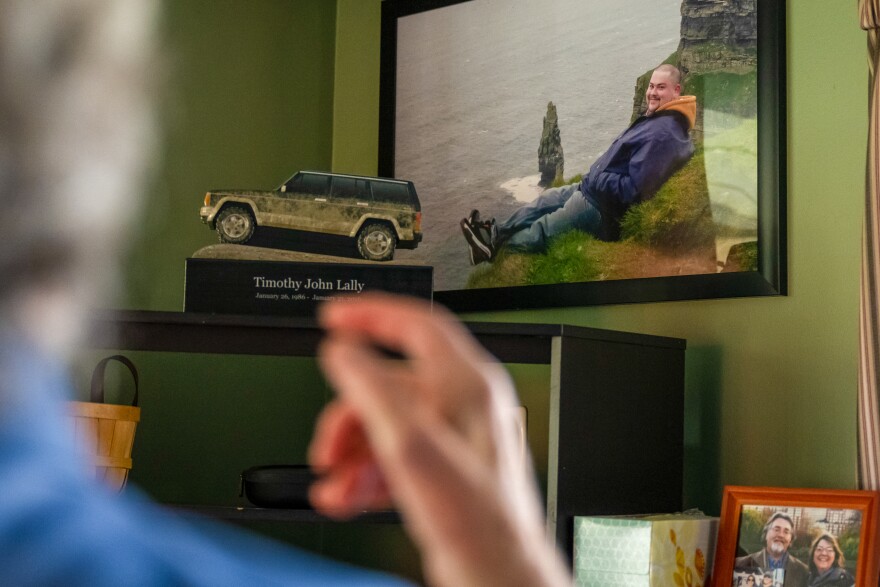At his house in Ellington where John Lally raised his firstborn, he stops beside a wall filled with photos.
“This is Tim on the guitar,” he said. “These are pictures throughout his life.”
The father chuckled softly, recalling his son Timothy Lally, and his rock band, “Go Hollywood.” He says he still listens to a recording from a concert his son played in Hartford in 2006.
In the photos, Timothy is smiling. He’s big on life. He’s alive.
Lally, a retired emergency room psychiatric nurse, said right after high school, Timothy began experiencing debilitating anxiety and panic attacks. Anti-anxiety medication didn’t help.
And then “one day someone gave him a Percocet, and he felt so good; he felt so calm. He said: ‘Dad, for the first time I could get through the day. My anxiety went away,’” Lally recalled. “You can think how tempting that would be then, to do it again the next day.
“But as we know, what happens with addiction — one pill turns into two pills turns into five pills,” Lally said. “Next thing you know, he’s addicted.”
Nearly eight years ago, Timothy died of a heroin overdose at the age of 29.
In another room in his home, Lally pointed to an urn filled with Timothy’s ashes. It’s “a copy of a Jeep Cherokee that Tim had. Tim and his buddies would go through the woods and through mud and they loved driving around in that Jeep. Some of his best times,” Lally said.
Turning loss into service

Today, Lally’s on the state’s 45-member advisory board whose task is to allocate opioid settlement funds in ways that prevent fatal overdoses. Pharmaceutical companies and distributors have paid $72.7 million of the $600 million expected in the next 20 years, following a series of federal lawsuits.
Lally is critical of the committee’s delays. Already this year, 800 people have died from opioid overdoses in Connecticut.
“I was very frustrated from day one,” he said. “By state statute, this committee was supposed to have started last October. We never got around to even meeting until six months ago.”
The money is sitting in a special account, but the state’s been slow to disburse it. It just made its first allocation on Nov. 14, nearly a year after the committee was legislated. And it was for programs promoting mental health, Narcan, and safer injections.
But there’s no universal agreement on how the money should be spent.
Some doctors and nurses want more support for maternal health
Megan Smith of the Connecticut Hospital Association is on the state’s settlement committee. She says hospitals are seeking funding for treating substance use disorder in moms and newborns.
“There is a gap between those who are diagnosed with a substance use disorder, in pregnancy for example, and those who receive treatment,” she said. “And so what we hear consistently is really a desire to help, starting probably prior to a person getting pregnant.”
But connecting high-risk patients with everything from social workers to lactation consultants takes time and money, said Dr. Christopher Morosky, professor of obstetrics and gynecology at the UConn School of Medicine and an OB-GYN at UConn Health.
“So it is resource-intense,” he said. “However, the payoff is great. What we find here in this hospital is that when we bring this team around them, they're very successful in their pregnancy, their birth, they go home with their babies, and their babies do very well in their communities.”
Morosky said intervention is important to make sure moms struggling with opioid use disorder stay with their children.
“These babies sometimes don't end up back with their families. And that has a real heavy cost to our patients, but also to their babies, and also to the greater society,” Morosky said. “So the amount of impact that the dollar spent on focusing on opioid use disorder in pregnancy is really elevated by the impact that it has.”
Towns take different approaches to the money
Different from the state, municipalities are directly paid by pharmaceutical companies and distributors. In Connecticut, 15% of the overall settlement goes to cities and towns.
How that money is spent is up to individual town committees, and depends upon each town’s need. And many of them are doing different things with the money.
In Manchester at nightfall this past August on National Overdose Awareness Day, families gathered at Northwest Park to watch a documentary on grief.
After the viewing, Samantha Bell from the Change Collaborative of Manchester handed out Deterra pouches. The pouches, purchased with settlement money, can be used to dispose of old prescription pills that people may have lying around the house.
“We’re trying to get them out of the hands of those who could be using them,” Bell said.
Hartford awarded Community Partners in Action $400,000. Mayor Luke Bronin said the city selected this particular nonprofit because it’s working to solve three interconnected crises at once — housing insecurity, substance use disorder and community reentry after incarceration.
But other towns, like New Haven, haven't allocated any of the money to date. So far, New Haven has received $550,000.
Maritza Bond, the city’s health commissioner and a member of the state disbursement committee, said she wants to be careful with how New Haven spends the money.
“I want to make sure that when we are disbursing it, we are looking at making sure that it’s sustainable,” Bond said. “So if we’re going to be allocating funds to external entities, there isn’t just a one-time allotted amount.”
That takes time.
Meanwhile, the city’s overdose deaths shot up more than 200% from 2019 to last year.
Once money is spent, tracking it also an issue
The fragmented process of tracking the money doesn’t make any of this easier. The settlement money doesn’t come all at once — and some of it shows up as direct payments to the state, excluding municipalities. Some of it is part of the McKinsey settlement fund, and a part of that has been spent. And this amount is not under the Opioid Settlement Advisory Committee’s purview.
Christine Minhee, an attorney based in Seattle, founded a national opioid settlement tracking website that keeps tabs on best practices.
She says many states, including Connecticut, aren’t collecting details about where the opioid settlement money is going exactly — and that municipal reporting requirements aren’t enough.
“These funding priorities are just so politically stated that it's hard to get to the true nature of what is actually being funded,” she said. “It ostensibly does not require recipients to list organizations that are receiving these monies. It does not require recipients to specify exactly which FDA approved drug is being used in any given context.”
Part of the problem, she said, lies in the paperwork.
Cities and towns are required to report on their funding priorities. But some of the paperwork is vague and confusing — and not all towns know exactly how to fill it all out. That can lead to a lack of clarity on how dollars are spent, she said.
For instance, a doctor asked Minhee how much their state has spent on naloxone, buprenorphine, and methadone, using opioid settlement dollars. But that data does not exist currently, even in “our higher reporting states, the states that are leading the way,” she said.
Minhee said the best reporting data comes from states whose municipalities are clear as to what they can spend the monies on, and use a national settlement spending template to complete their expenditure reports, which North Carolina is doing.
In Connecticut, the deadline for submitting municipal forms was extended. As Lally explained, “some of them were late, and some towns weren’t even sure what they were supposed to do or were confused. That is an issue.”
And in some, the funding was delayed because of a technical glitch in bank transfers. Now, all but four of Connecticut's 169 municipalities have sent in their forms.
Getting money out the door is a challenge. But so is keeping track of it.
Nancy Navaretta, head of the Connecticut Department of Mental Health and Addiction Services, and the committee’s chair, said the group is deeply invested in getting money out to the people who need it the most.
“I would like to get through this first iteration,” she said. “And if we do need to improve the process by which we do this, if we say for next year's report these are the improvements that we want to make, I think we can easily do that.”
The committee wants to be aggressive in getting the dollars out to communities, she said, but members also “want to be very intentional. So what we don't want to happen is to do something that is perceived as not being transparent and have to go backwards.”
Some states have already received criticism in the way they spent their settlement funds.
“I think the most repugnant examples are probably [U.S. Sen.] Joe Manchin’s attempt to use Purdue monies for a personal gubernatorial helicopter [when he was governor],” Minhee said. “So we are certainly seeing opioid settlement spending that reminds us of some of the nightmares that we still remember from our big tobacco spending era.”
To Lally, making sure the settlement money gets to the people who urgently need it has become his calling.
As he stands by the urn holding the ashes of his son Timothy, he says the entire committee wants to get this right.
“I miss him,” he said softly. “And you know when you lose a child, it’s like A.D. and B.C. — it’s like before Tim’s loss and after Tim’s loss. The world is just a very different place.
"I try to honor him and his memory through the work I do.”





